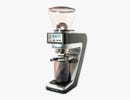




If you want to make good coffee at home, you need a coffee grinder. These are the only ten you need to consider.

As it pertains to making better coffee in the morning, no decision yields a greater effect than switching from pre-ground to whole-bean coffee. Roasted whole bean coffee carries with it the aromatics of the bean for a few weeks after roasting, and remains stable and “fresh” for much longer. Pre-ground coffee expels all the bean’s natural aromatic and exposes the grounds to particles that distort flavor — in other words, pre-ground coffee is stale coffee.
To convert whole bean coffee to ground coffee, we need a coffee grinder. But not all grinders are created equal. We tested what most experts consider the world’s best coffee grinders, comparing size, speed, price and performance, to identify which machines to buy, and these are the ten best coffee grinders to buy.
A rule of thumb: burr grinders rule, blade grinders drool. Where a blade grinder works more like a blender, chopping away at beans at the blade level, burr grinders effectively chew and crush beans. The difference between the two is dramatic. When coffee is put in a blade grinder — which are typically inexpensive and designed for spice grinding — only the beans that are in contact with the blade are brought to size. This means the beans that sit below the blade, or wedge themselves into corners, are left at a completely different size, while the beans at blade level are turned to dust.
"A nice burr grinder is going to allow you to dial in your grind setting exactly to how it's brewing," says Natalie Van Dusen, founder of Montana's Treeline Coffee Roasters. "Using a blade grinder is equivalent to chopping your coffee into uneven pieces. This results in an inconsistent cup, because you have an inconsistent grind setting." In other words, pots of coffee made with a blade grinder will never be replicable.
But even after you choose to go with a burr grinder, you're still left with one more choice to make: conical burrs or flat burrs. Flat burrs are more expensive to manufacture and therefore are often found in pricer grinders, but one type is not necessarily better than the other. Flat burrs generally offer more consistency and uniformity in their grinds, which is good, but they can also retain more grounds and are more difficult to clean, which is not so good. It all depends on your preferences.
With coffee grinders, the heavier the better. There are a few reasons for this. One, more weight means the machine’s motor won’t knock itself out of calibration or grind setting mid-grind. But it also means the grinder you’re buying — a relatively small machine tasked with crushing coffee beans for 30 seconds every day — is less liable to break internally because there’s less plastic and more metal.
No matter how nice the machine, every grinder requires service now and again. Even if there’s not a mechanical issue, you’ll need to remove the burr and guts of the machine to clean coffee from months ago off the internal gears. If you can’t take it apart easily, don’t buy it.
While not an outright necessity, you may look to save some counter space by opting for a grinder with a built-in scale. In the age-old question of whether to grind coffee by weight or volume, weight comes out on top, as it's simply a more accurate way of measuring how much coffee you're using. This means it leads to more consistent grinds, and as we've mentioned already, consistency matters when it comes to great coffee.
Our recommendations are based on real-world testing. Here's a snapshot of new and unreleased coffee grinders that we're considering for future updates to this guide.
Baratza Encore ESP: Baratza's Encore is an all-time classic, but like the Fellow Ode, it doesn't grind fine enough for espresso. The Encore ESP solves this problem with the addition of 20 micro-step adjustments and an included dosing cup.